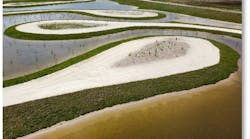Project Profile: London 2012 Games Bring New Flood Protection to Developing Community
Spectators from around the globe have been watching the London 2012 Olympic and Paralympic Games, enthralled by world-class athletes participating in stunning competitions. It’s a safe bet to imagine that few in the crowd have thought about flooding, though flood safety was an essential factor in the creation of the new Olympic Park, site of Olympic Stadium and numerous other competition venues. To keep floodwaters controlled, 2 miles of riverbanks were redesigned and reengineered as the spectacular Olympic Park was created.
Brownfield River Banks
The River Lee and a series of other rivers (collectively called the Bow Back Rivers), which feed into the Lee, thread through the Lee Valley in northeast London en route to the River Thames. Between 2006 and 2012, 1 square mile of the Lower Lee Valley was transformed from a rundown, heavily contaminated site into the Olympic Park.
The Olympic Delivery Authority (ODA) hired Atkins as the official engineering design services provider for the 2012 Games in 2005. In addition to heading up the “enabling works” (remediation and preparation) of the Olympic Park site for development and construction of sports venues, Atkins also designed and reengineered the banks of the River Lee and managed biodiversity and habitat creation within the new park.
Nearly 2 miles of river banks and canals crossing the park site needed to be revitalized when work began along the River Lee in 2008, roughly two years into the site enabling works, which were ongoing at the time. Park master planner and landscape architect LDA Design/Hargreaves collaborated with Atkins on the four-year project, which included hydraulic modeling, bioengineering of the riverbanks, trial plantings, and creation of large urban wetland habitats.
Flood Risk Effect on Olympic Park
Flood risk had to be addressed first in compliance with UK planning law, which requires specific consideration of the 1-in-100 year flood risk over the lifetime of the development and includes the impact of climate change. A formal flood risk assessment was undertaken through detailed 2D computational modeling and demonstrated a positive impact on flood risk for the park and surrounding communities.
To improve navigation on the River Lee for barge traffic, a set of tide gates and a boat lock were installed roughly 1,200 yards south of the park site in 2008. The gates and lock prevented water loss from the River Lee during low tide in the River Thames. Twice daily the tide gates are closed and the water level of the River Lee (177 cubic feet per seconds–cusecs–of average daily flow) fluctuates by 1.3 feet on average. Realizing a grey area between the 1-in-100 year flood level and normal river fluctuations, Atkins wanted to better understand the impacts of rainfall.
Daily flood risk was predicted by computer modeling of the river flows and levels along the Lee floodway and the five waterways that cross through Olympic Park. After flood risk and geotechnical data were analyzed, the decision was made to slope of the riverbanks to 1 in 2.5 (roughly 22 degrees). The park design included a fairly low bank treatment to create a feeling of openness and to bring the public closer for exploration of wetland habitats along the river. Still, the predicted frequent flood levels required raising public footpaths by 4 feet for additional safety from inundation.
The flood risk data were also applied to help determine the park’s shape and flood resilience, as well as wetland landscaping approaches and maintenance. For example, steeper riverbanks were engineered under the park’s bridges to maintain channel conveyance, and the regulation of water levels in three ponds required knowledge of daily water level variations.
The new Olympic Park layout included a large wetland bowl and rare wet woodlands, within a landscape of broad lawns, meadows, grasslands, and wooded glens. To make the required space for the park, a neglected section of the Channelsea River had to be incorporated.
The Channelsea was a tidal river that could have contributed to flood conditions at the new park and nearby communities. The solution required culverting a 328-yard section of the Channelsea by collecting it in a concrete box culvert (10 by 9 feet) from the perimeter of Olympic Park. The culvert also intercepts the overland flow (up to 460 cusecs) from the Dagenham Brook and the River Lee and diverts it back into River Lee within the park. The culvert is buried 27 feet beneath the park’s landscaping.
Together, the reengineered slopes of the River Lee and the culverted section of the Channelsea River have lifted more than 4,100 residences out of the floodplain in east London.
River-Edge Ponds Add Biodiversity
To further improve flood control and create more biodiversity in the park, three river-edge ponds were created at the north end of the Olympic Park. All three ponds are fed by surface water drainage collected from concourse areas near sport venues. Bioswales are scattered through the park landscape to collect and convey water before discharging it into the ponds. Two vernal ponds will dry in summer.
The third pond is larger and will retain water throughout the year, though keeping it from drying out or overtopping required a more complicated solution given the hydraulics of the impounded River Lee. A connection between the pond and the river was designed to function as both an overflow and feed–depending on the fluctuating river levels. When the pond’s water level rises too high, water drains back into the river through a non-return valve. When the pond begins to dry out, a manually operated gate-valve can be opened to allow water from the river to flow into the pond. Levels of pipework that correlate with varying river levels enable the process.
Two groves of rare wet woodlands were also created. Shallow depths of water in the groves provide the boggy conditions necessary for trees that normally grow in Scotland’s northern climates. The groves are encircled by a low earthen embankment that is overtopped by the River Lee during high tide in the River Thames–about once every four weeks–to flood the woodlands. Low banks of the grove, formed with alluvial material and covered in prevegetated plant mats, capture the river water and prevent it from returning to the channel.
Sustainable Habitats Along Restored Waterways
Creating sustainable parklands was a major goal of the ODA. A one-year riverside planting trial began in 2008 to determine which plants would survive the regulated manmade conditions of the impounded River Lee. A landscaping scheme was devised for the newly created riverbanks. Plant species were tested using different installation approaches, and either thrived or withered at varying elevations along the banks. Eventually, more than 300,000 native plants from 47 species were planted along the river edge and wetlands to create new habitats for otters, kingfishers, grey herons, bees, lizards, frogs, and other birds, insects, amphibians, and reptiles.



